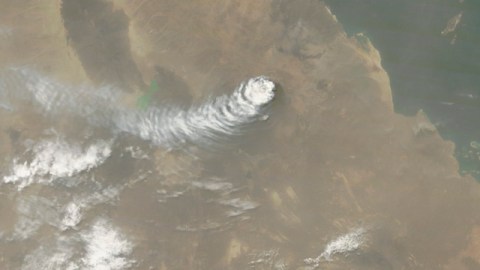Watching the continuing Nabro eruption from space

We’re still getting little in the way of news about the Nabro eruption from Eritrea – I’ve been looking around and the best figure I’ve found is that at least 3,500 people and up to 9,000 that have been effected by the eruption (and 7 deaths) at the remote caldera, although that number is likely much higher when you include people in Ethiopia as well. According to this report, the flow has covered 20 km, but I’m not sure if that means it has travelled 20 km or covers 20 square kilometers (my guess is the former). The best evidence we have of what is going on are the excellent images taken from space of the activity at Nabro – you can check out the full gallery of images from the NASA Earth Observatory. The latest image (below) shows the strong plume coming from the southern edge of the caldera along with the lava flow to the west-northwest that is still degassing – not too surprising from a hot, low viscosity basaltic lava flow. The plume is still very robust, albeit very white suggesting a lot of steam in the plume with the significant ash as well. The latest VAAC statement from Toulouse says that no ash is visible in the satellite imagery, but as recently as yesterday there was still a small plume reported over eastern Africa – and a small plume (top left) was seen in the satellite imagery last week as well.

The activity at Nabro as seen on June 24, 2011. The eruptive activity continues to have both a prominent explosive component (plume) and lava flows. Image courtesy of the NASA Earth Observatory. Click here to see a larger version.
UPDATE 2:30 PM Eastern: I’ve added a short wave infrared/infrared/visible composite of the Nabro eruption as well (below; again, thanks to the folks at the NASA EO) that clearly shows the lava flows to the WNW.

Top left: MODIS image of the Nabro eruption as seen on June 22, 2011. Image courtesy of the NASA Earth Observatory.





